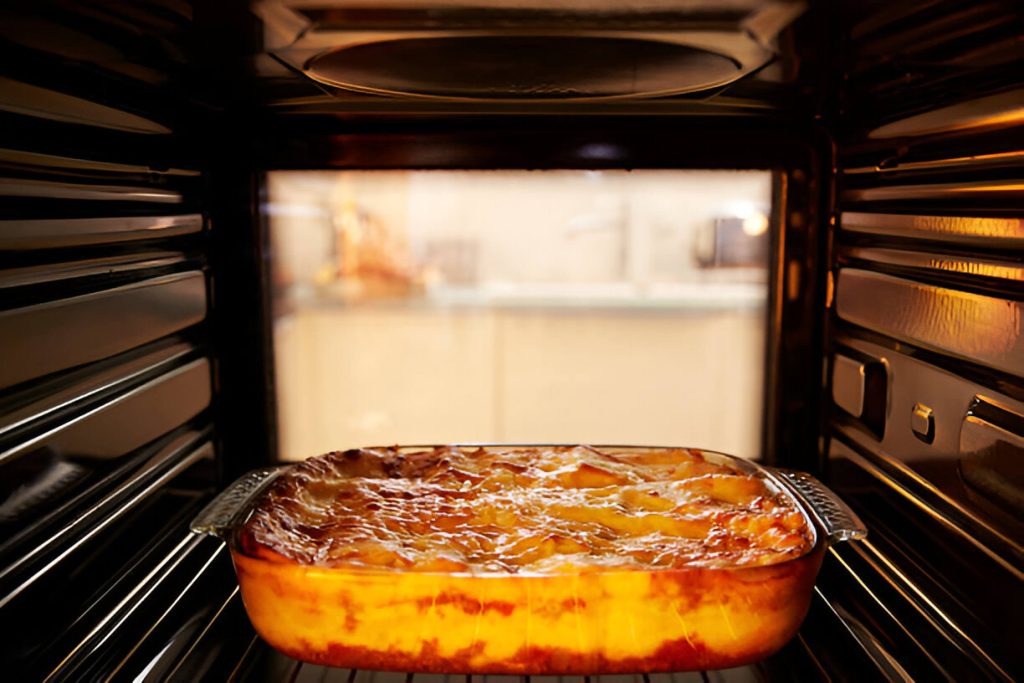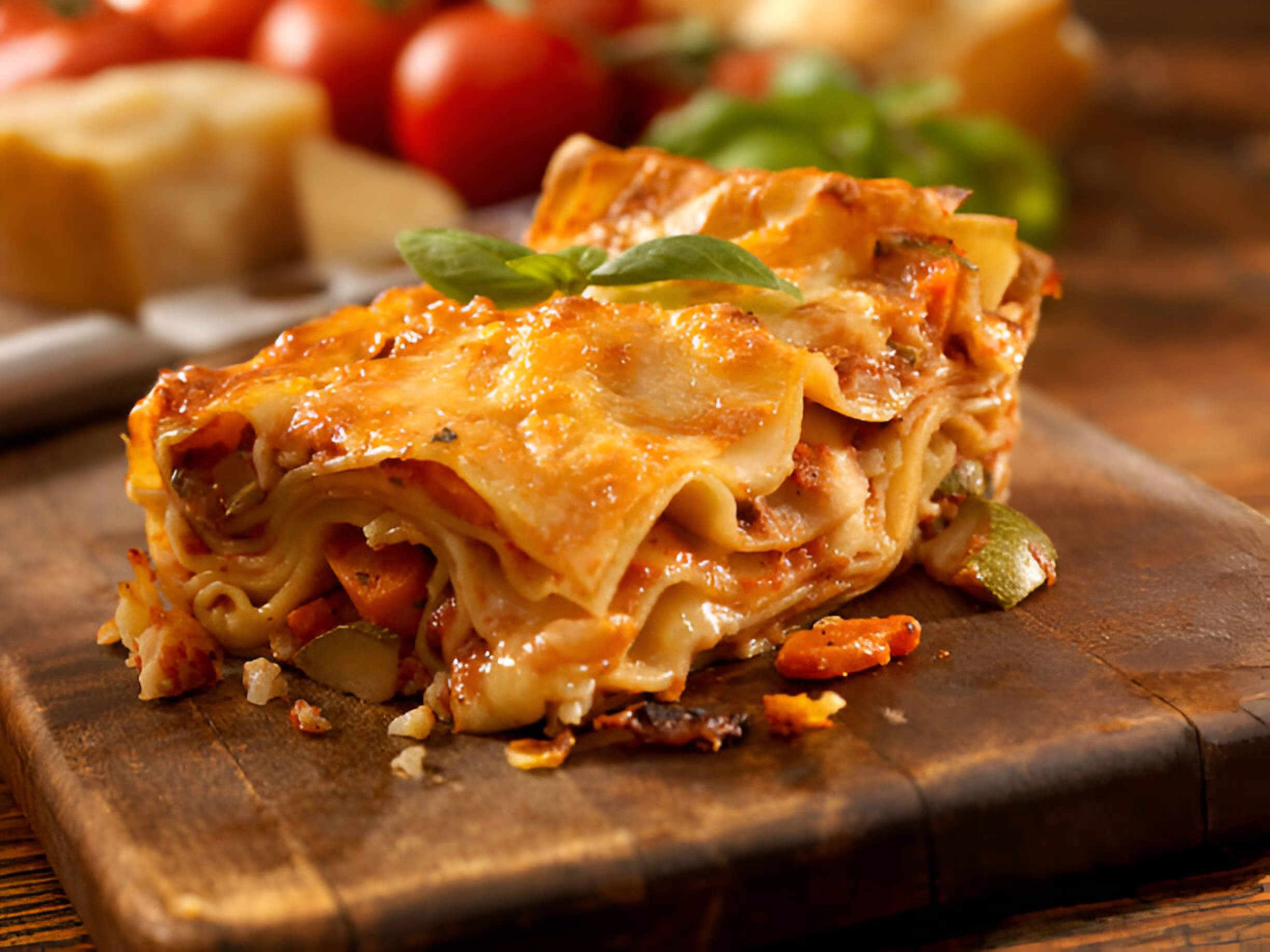When preparing lasagna, cooking times can vary depending on the type of recipe and ingredients used. For traditional lasagna with pre-boiled noodles, baking typically takes 45-60 minutes at 375°F (190°C). No-boil lasagna, which uses specially designed noodles, usually requires 45-55 minutes in the oven at the same temperature.
Vegetarian lasagna often cooks faster due to its lighter ingredients, generally needing 35-45 minutes at 375°F (190°C). On the other hand, meat lasagna may require slightly longer cooking times, ranging from 50-65 minutes, to ensure the meat is thoroughly cooked.
Regardless of the type, it’s essential to cover the lasagna with foil for the first 25-30 minutes of baking to prevent the top from burning. Always check for doneness by ensuring the internal temperature reaches 165°F (74°C) and the cheese is golden and bubbly. Let the lasagna rest for 10-15 minutes before serving to allow the layers to set.
The Basics of Lasagna Preparation
Lasagna, a beloved Italian dish, is a masterpiece of layers and flavors. To create this culinary delight, understanding the basics of lasagna preparation is essential. Begin by gathering quality ingredients: lasagna noodles, your choice of sauce (typically tomato-based), cheese, and optional fillings like ground meat or vegetables.
The art of layering lasagna is crucial to its success. Start with a thin layer of sauce at the bottom of your baking dish to prevent sticking. Then, place a layer of lasagna noodles, followed by sauce, cheese, and any additional fillings. Repeat this process, creating multiple layers until you reach the top of your dish.
When assembling lasagna, pay attention to the consistency of each layer. Ensure that sauce and cheese are evenly distributed to avoid dry spots. Some prefer to pre-cook their lasagna noodles, while others opt for no-boil varieties. Whichever you choose, make sure the noodles are completely covered by sauce to ensure proper cooking.
Patience is key when preparing lasagna. Allow time for the flavors to meld and the layers to set before serving. With practice and attention to detail, you’ll master the art of creating a perfectly balanced and delicious lasagna.
Factors Affecting Lasagna Cooking Time

Several factors influence the cooking time of lasagna, making it essential to consider these variables for a perfectly baked dish. Oven temperature plays a crucial role, with higher temperatures generally resulting in shorter cooking times. However, it’s important to balance this with the risk of burning the top layer.
The size and thickness of the lasagna also significantly impact cooking duration. Larger, deeper dishes will naturally require more time to heat through to the center. Similarly, the density of ingredients affects cooking time; lasagnas with heavier, more moisture-rich fillings may need extended baking periods.
The material of the baking dish is another important consideration. Glass and ceramic dishes tend to heat more slowly but retain heat longer, while metal pans conduct heat more quickly. This can affect both the initial cooking time and how the lasagna continues to cook once removed from the oven.
By taking these factors into account, home cooks can better estimate and adjust their lasagna cooking times, ensuring a delicious and properly cooked meal every time.
Step-by-Step Guide to Cooking Lasagna
Begin by preheating your oven to 375°F (190°C) to ensure it’s at the right temperature when you’re ready to bake. While the oven is heating, assemble your lasagna layers in a deep baking dish, alternating between pasta sheets, sauce, and cheese. Once assembled, cover the lasagna with aluminum foil to prevent the top from burning and to keep moisture in during cooking.
The baking time for a typical lasagna is around 25 minutes covered, followed by an additional 25 minutes uncovered. This allows the cheese to melt and brown nicely on top. Always check that the internal temperature reaches 165°F (74°C) to ensure it’s fully cooked.
After removing the lasagna from the oven, it’s crucial to allow for a resting period of about 15 minutes. This resting time lets the layers settle and makes it easier to cut and serve without falling apart. During this time, the flavors will also continue to meld, resulting in a more delicious final product.
Signs of a Perfectly Cooked Lasagna
When it comes to achieving lasagna perfection, several key indicators can help you determine if your dish is ready to be served. First, look for a golden brown top layer, which signifies that the cheese has melted and caramelized beautifully. The edges of the lasagna should be bubbly, indicating that the sauce and cheese have reached the ideal temperature throughout the dish.
For a more precise measurement, use a food thermometer to check the internal temperature. A perfectly cooked lasagna should reach 165°F (74°C) at its center, ensuring that all ingredients are thoroughly heated and any potential bacteria have been eliminated.
Lastly, perform a texture check by inserting a knife or fork into the center of the lasagna. It should slide in easily, meeting little resistance from the pasta layers. When you remove the utensil, the layers should hold their shape without collapsing, signifying that the lasagna has set properly.
Common Mistakes to Avoid When Cooking Lasagna
When preparing lasagna, several pitfalls can compromise the dish’s quality. One common error is overcooking, which can lead to a dry, unappetizing result. Conversely, undercooking can leave the pasta too firm and the flavors underdeveloped. Achieving the right balance is crucial for a perfect lasagna.
Another frequent mistake is creating a soggy lasagna. This often occurs when excess moisture isn’t properly managed, such as not draining the ricotta or using overly watery sauce. To avoid this, consider straining your ricotta and cooking down your sauce for a thicker consistency.
Dry lasagna, on the other hand, can result from using too little sauce or overbaking. Ensure you have enough sauce to coat each layer generously, and monitor your baking time closely. Remember, lasagna continues to cook slightly after removing it from the oven.
Tips for Reheating and Storing Lasagna
Properly reheating and storing lasagna can help maintain its delicious flavor and texture. When reheating, consider using an oven for best results. Preheat to 375°F (190°C), cover the lasagna with foil, and heat for about 25-30 minutes. Alternatively, microwave individual portions for 2-3 minutes, stirring halfway through.
For storage, refrigerate leftover lasagna in an airtight container for up to 3-5 days. If freezing, wrap the lasagna tightly in plastic wrap and aluminum foil, or use a freezer-safe container. Frozen lasagna can last up to 3 months.
When freezing lasagna, consider portioning it into individual servings for easier reheating. To thaw frozen lasagna, transfer it to the refrigerator overnight before reheating. This ensures even warming and helps preserve the dish’s texture.
Remember to always check that reheated lasagna reaches an internal temperature of 165°F (74°C) to ensure food safety. By following these tips, you can enjoy your leftover lasagna as if it were freshly made.






